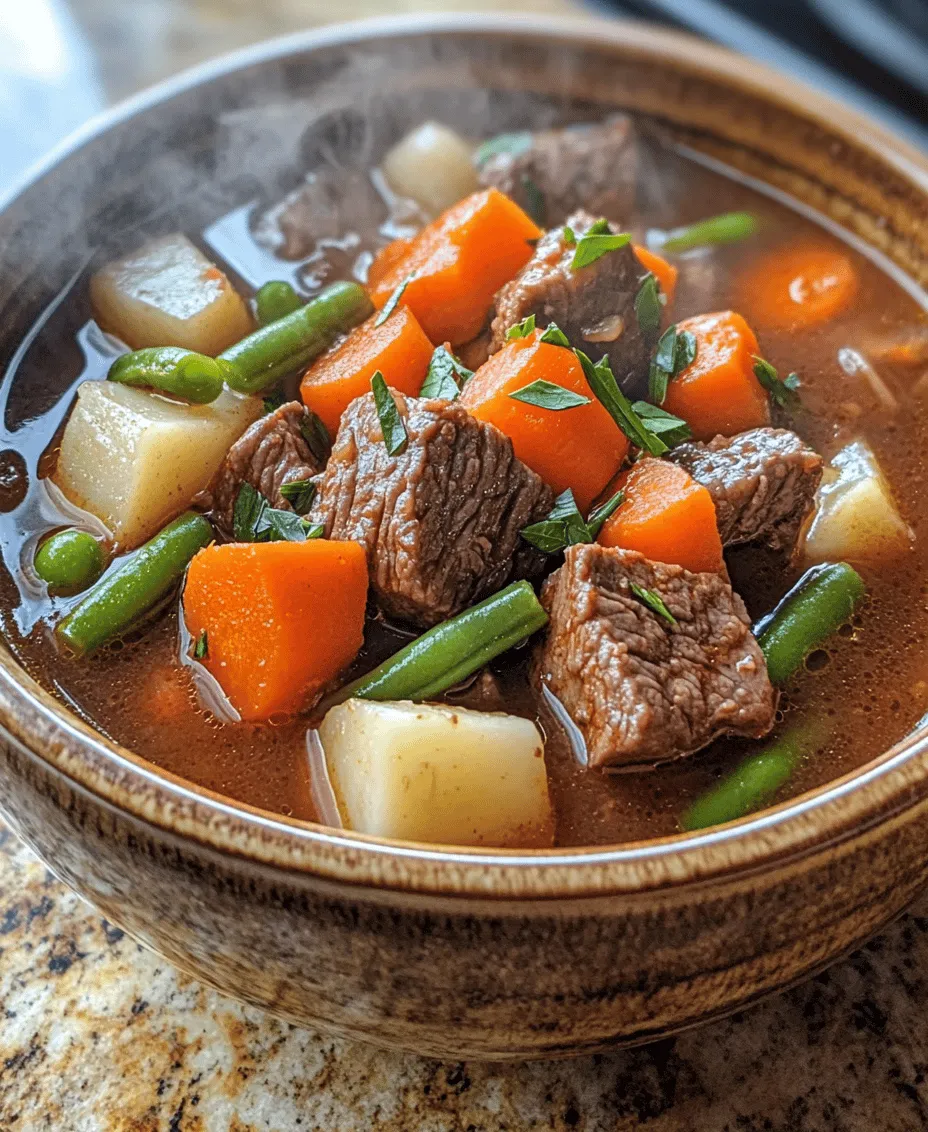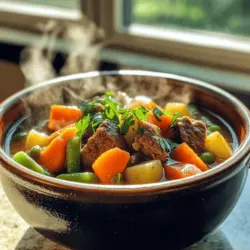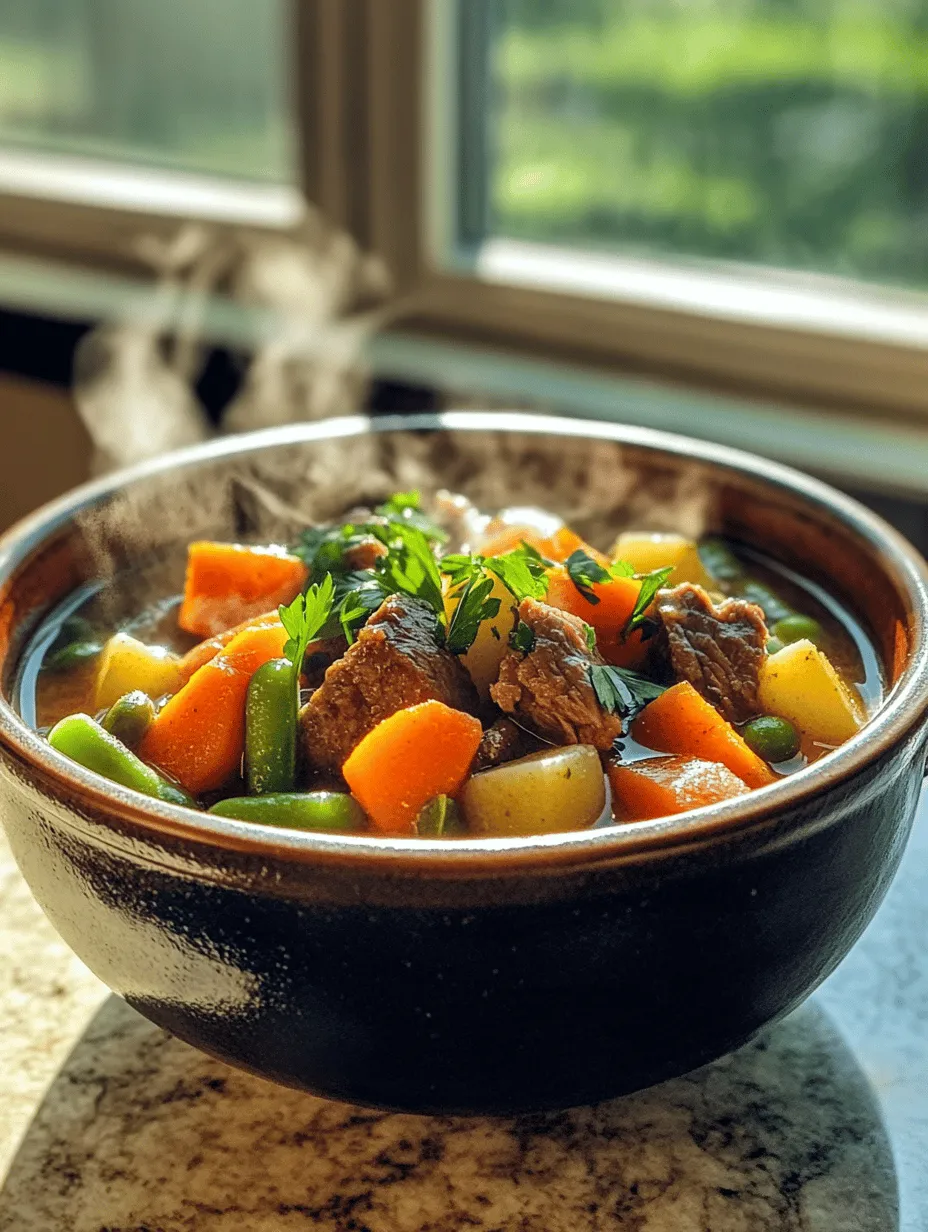Introduction
In the realm of comfort food, few dishes hold the same revered position as a warm bowl of homemade soup. Across cultures and generations, soup has served not only as a nourishing meal but also as a source of comfort and warmth on chilly days. The act of gathering around a pot of simmering soup brings families and friends together, fostering connections over shared flavors and memories. Among the wide array of soup recipes, Hearty Homemade Vegetable Beef Soup stands out as the quintessential dish for cold weather or family gatherings, combining rich flavors, wholesome ingredients, and a satisfying heartiness that warms both the body and soul.
This delightful soup is not just a meal; it’s an experience. The aroma of beef and vegetables mingling together creates an inviting atmosphere, while the vibrant colors of the fresh ingredients promise a feast for the senses. Hearty Homemade Vegetable Beef Soup is versatile and can be customized to incorporate seasonal vegetables or whatever you have on hand. Whether you’re serving it as a main dish or alongside crusty bread, this soup is sure to become a cherished addition to your recipe collection. Let’s discover what makes this dish so special and the steps involved in creating your very own pot of comfort.
The Nutritional Benefits of Vegetable Beef Soup
Food is not only meant to satisfy hunger; it also plays a crucial role in our overall health and well-being. Hearty Homemade Vegetable Beef Soup is a prime example of how a simple meal can pack a nutritional punch while still being incredibly satisfying. Each ingredient in this soup serves a purpose, contributing to a deliciously balanced dish.
Beef: A Powerful Protein Source
At the heart of this soup is the beef, typically cut from stew meat, which offers a robust flavor and tender texture when cooked slowly. Beef is a fantastic source of high-quality protein, essential for building and repairing tissues in the body. It also provides vital nutrients such as iron, zinc, and B vitamins. Iron, particularly, is crucial for transporting oxygen in the blood, making it an important component of a healthy diet.
Vegetables: The Nutritional Powerhouses
The real stars of this soup are the vegetables. A medley of carrots, celery, potatoes, and green beans not only adds flavor and texture but also infuses the dish with essential vitamins, minerals, and fiber. Carrots are an excellent source of beta-carotene, which supports eye health, while celery offers hydration and is low in calories. Potatoes provide energy and fiber, and green beans contribute vitamins A, C, and K.
Broth: The Foundation of Flavor
The broth is the soul of any soup, and in this recipe, it serves as both a hydrating element and a flavor enhancer. A rich, homemade beef broth not only deepens the flavor of the soup but also provides minerals and collagen, which support joint and skin health. Using a broth made from simmering beef bones and vegetables can elevate the nutritional profile of your soup even further.
A Balanced Diet in a Bowl
When combined, these ingredients create a balanced meal that can contribute positively to your dietary needs. The protein from the beef, the fiber and vitamins from the vegetables, and the hydration from the broth work together to create a nourishing dish that satisfies hunger while promoting overall health. Whether enjoyed on a cold winter’s night or during a joyful family gathering, this soup is a perfect example of how comfort food can be both delicious and nutritious.
Ingredients Breakdown
Creating the perfect Hearty Homemade Vegetable Beef Soup starts with selecting the right ingredients. Each component contributes to the soup’s flavor, texture, and nutritional value. Below is a detailed breakdown of the primary ingredients you’ll need, along with tips on preparation.
Beef Stew Meat
The backbone of the soup is the beef stew meat. Opt for cuts like chuck or brisket, which become tender and flavorful when simmered. When selecting your beef, look for well-marbled cuts, as the fat will render during cooking, adding richness to the broth. Cut the meat into bite-sized pieces, trimming away any excess fat to prevent greasiness.
Olive Oil
Using olive oil as your primary cooking fat is not only a healthier choice but also adds a wonderful depth of flavor to your soup. Rich in monounsaturated fats, olive oil is known for its heart-healthy benefits. It also has anti-inflammatory properties and is packed with antioxidants. When sautéing your vegetables and browning the beef, a drizzle of extra virgin olive oil will enhance the overall taste of the dish.
Fresh Vegetables
Fresh vegetables are key to achieving the vibrant flavors and textures in your soup. While the recipe typically calls for carrots, celery, potatoes, and green beans, feel free to customize it based on seasonal produce or personal preferences. Choose firm, fresh vegetables with bright colors, as they tend to be more flavorful and nutritious. For the best results, chop the vegetables into uniform pieces to ensure even cooking.
Herbs and Spices
Herbs and spices play a crucial role in elevating the flavor profile of your soup. Fresh thyme, parsley, and bay leaves can add aromatic notes, while a dash of black pepper and salt enhances the overall taste. Consider adding a pinch of garlic powder or a splash of Worcestershire sauce for additional depth. The key is to balance the flavors without overpowering the natural taste of the ingredients.
Step-by-Step Instructions for Hearty Homemade Vegetable Beef Soup
Now that you have a grasp on the ingredients, it’s time to dive into the cooking process. Follow these step-by-step instructions for crafting your Hearty Homemade Vegetable Beef Soup.
1. Browning the Beef
The first step in creating a rich and flavorful soup is to brown the beef stew meat. Start by heating a large, heavy-bottomed pot or Dutch oven over medium-high heat. Add a tablespoon of olive oil and let it heat until shimmering.
Carefully add the beef pieces in a single layer, ensuring not to overcrowd the pot. This step is crucial; overcrowding will steam the meat instead of browning it. Allow the beef to sear undisturbed for a few minutes until a golden-brown crust forms. Flip the pieces to brown all sides evenly. This process caramelizes the natural sugars in the beef, creating a deeper flavor profile for your soup. Once browned, transfer the beef to a plate and set it aside.
2. Sautéing the Vegetables
In the same pot, reduce the heat to medium and add another drizzle of olive oil if needed. Toss in the chopped onions, carrots, and celery. Sauté the vegetables for about 5-7 minutes until they soften and the onions become translucent. Stir occasionally to prevent sticking or burning.
Next, add the diced potatoes and green beans, stirring to combine. The fresh vegetables will begin to release their moisture, creating a flavorful base for the soup. This step allows the vegetables to absorb the leftover drippings from the browned beef, enhancing the overall flavor of the dish.
3. Building the Broth
Once the vegetables are softened, it’s time to build the broth. Return the browned beef to the pot, along with any juices that have accumulated on the plate. Pour in enough beef broth to cover the ingredients—about 6-8 cups, depending on how much soup you want to make. If you prefer a thicker soup, use less broth.
Add in the herbs, spices, and seasonings, including bay leaves, thyme, salt, and pepper. Stir the mixture gently to combine, ensuring all ingredients are evenly distributed.
4. Simmering the Soup
Increase the heat to bring the soup to a gentle boil, then reduce the heat to low to maintain a simmer. Cover the pot with a lid slightly ajar to allow steam to escape. Let the soup simmer for at least 1.5 to 2 hours, stirring occasionally. This slow cooking process allows the flavors to meld together beautifully, and the beef will become tender and juicy.
As the soup simmers, taste and adjust the seasoning as needed. If you prefer a more robust flavor, consider adding a splash of Worcestershire sauce or a sprinkle of garlic powder about halfway through the cooking time.
5. Adding Final Touches
Once the beef is tender and the vegetables are cooked through, it’s time to finish your Hearty Homemade Vegetable Beef Soup. Remove the bay leaves and any sprigs of herbs before serving. For a touch of freshness, stir in a handful of chopped parsley just before serving.
Your soup is now ready to be ladled into bowls and enjoyed, either on its own or with a side of crusty bread for dipping.
This hearty soup represents the essence of comfort food—nourishing, flavorful, and perfect for sharing with loved ones. Enjoy making this dish, and prepare to fill your home with the delightful aroma of a homemade masterpiece.

Sautéing Vegetables: Why This Step is Crucial for Flavor Development
Sautéing vegetables is one of the most critical steps in creating a rich and flavorful Hearty Homemade Vegetable Beef Soup. This technique not only softens the vegetables but also enhances their natural sweetness through caramelization. When you sauté onions, garlic, and other aromatics, you unlock a deeper flavor profile that serves as the backbone of the soup.
To start, heat a tablespoon of olive oil or butter in a large pot over medium heat. Add diced onions, minced garlic, and any other hard vegetables like carrots and celery. Sauté these ingredients for about 5-7 minutes until they are tender and slightly golden. This process releases essential oils and natural sugars, which contribute significantly to the overall taste of your soup. The key here is to avoid overcrowding the pot; if necessary, sauté in batches to ensure even cooking.
Combining Ingredients: Tips for Layering Flavors Effectively
Once your vegetables are sautéed to perfection, it’s time to combine the remaining ingredients for your vegetable beef soup. The layering of flavors is vital for achieving a well-balanced and delicious final product. Here are a few tips:
1. Build the Base: After sautéing, add your beef (preferably chuck or stew meat) to the pot. Brown the meat for a few minutes to develop those rich, savory flavors before adding liquids.
2. Add Broth Gradually: Pour in your broth (beef or vegetable, depending on your preference) gradually while scraping the bottom of the pot. This technique helps deglaze the pan, releasing any flavorful bits stuck to the bottom.
3. Incorporate Vegetables: Next, add your remaining vegetables, such as potatoes, green beans, and peas. Each vegetable contributes its unique flavor, and by adding them in stages, you can control their texture and taste.
4. Stir and Simmer: Stir the mixture well and bring it to a gentle boil before reducing the heat to low. Allowing the soup to simmer enables the flavors to meld beautifully.
Seasoning the Soup: Understanding the Role of Herbs and Spices
Seasoning is the finishing touch that elevates your Hearty Homemade Vegetable Beef Soup from good to great. Here’s how to effectively season your soup:
- Herbs: Fresh herbs like thyme, rosemary, and parsley are excellent additions. Add dried herbs early in the cooking process to allow their flavors to infuse, but reserve fresh herbs for the end to maintain their vibrant taste.
- Spices: Consider adding spices such as black pepper, bay leaves, and paprika for warmth and depth. A dash of Worcestershire sauce or soy sauce can also enrich the umami flavor.
- Salt: Be mindful of how much salt you add. Start with a small amount and taste as the soup simmers, adjusting as needed. Remember that the broth may already contain salt, so it’s better to err on the side of caution.
Cooking Time and Temperature: Importance of Patience in Developing Flavor
The cooking time and temperature are crucial factors in achieving a perfectly flavored soup. After combining all the ingredients, bring the soup to a gentle boil, then lower the heat and cover the pot. Allow it to simmer for at least 1.5 to 2 hours. This slow cooking process allows the beef to become tender and the vegetables to meld their flavors into the broth.
Patience is key. The longer you let the soup simmer, the more intense and complex the flavors will become. If you’re short on time, it’s acceptable to shorten the cooking time, but keep in mind that a longer simmer results in a richer, heartier soup.
Cooking Tips for Perfect Soup
- Adjusting Cooking Times: Depending on your preference for beef tenderness, you may choose to cook your soup longer or shorter. If you prefer more tender beef, aim for at least 2 hours of simmering.
- Ingredient Substitutions: If you have dietary needs, there are many substitutions you can make. For a gluten-free version, use gluten-free broth and avoid any thickeners that contain gluten. For a vegetarian soup, simply replace the beef with hearty mushrooms and use vegetable broth as your base.
- Storage and Reheating: To store your soup, allow it to cool completely before transferring it to an airtight container. It can be refrigerated for up to 4 days or frozen for up to 3 months. When reheating, add a splash of broth or water to maintain the ideal consistency and prevent drying out.
Serving Suggestions
The presentation and accompaniments can enhance the overall experience of enjoying your Hearty Homemade Vegetable Beef Soup. Here are some creative ideas:
- Accompaniments: Serve your soup alongside crusty bread or a fresh green salad. A simple vinaigrette can add a refreshing contrast to the rich flavors of the soup.
- Creative Serving Methods: Consider serving your soup in bread bowls for a fun and interactive dining experience. You can also garnish individual servings with grated cheese, fresh herbs, or a dollop of sour cream for added richness.
- Presentation Tips: Use colorful bowls to serve your soup, and consider garnishing with freshly chopped parsley or a sprinkle of paprika for visual appeal. A warm, inviting table setting can also elevate the meal experience.
The Versatility of Vegetable Beef Soup
One of the best things about Hearty Homemade Vegetable Beef Soup is its versatility. Here are some ideas to customize the recipe to your taste and seasonal availability:
- Variations: Feel free to experiment with different vegetables like zucchini, bell peppers, or leafy greens such as spinach or kale. Adding beans can also turn the soup into a more filling meal.
- International Variations: Explore global flavors by incorporating spices or ingredients from various cuisines. For instance, adding cumin and coriander can give your soup a Mexican twist, while soy sauce and ginger can offer an Asian flair.
- Incorporating Leftovers: This soup is an excellent way to use up leftover vegetables or cooked meats. Adapt the recipe according to what you have on hand. Additionally, in colder months, consider using winter vegetables like squash or root vegetables for a seasonal touch.
Conclusion
Hearty Homemade Vegetable Beef Soup is not just a meal; it’s a comforting hug in a bowl that nourishes both body and soul. Packed with nutritious vegetables and flavorful beef, this soup is perfect for any occasion, whether it’s a chilly evening or a gathering with loved ones. Making it at home allows you to control the ingredients and create a dish that is tailored to your family’s tastes.
We encourage you to try making this recipe in your kitchen. Enjoy the process of cooking and the satisfaction that comes with sharing a warm, delicious meal. There’s something incredibly rewarding about gathering around the table with family and friends, sharing stories and laughter over a bowl of homemade soup. Embrace the joy of cooking and create memorable moments with your loved ones today.


